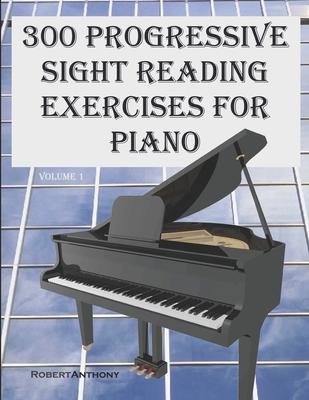
Book
300 Progressive Sight Reading Exercises for Piano
(Write a Review)
Paperback (Large Print)
$22.49
A: This book is for anyone who wants to train their ability to read music well without being dependent on finger numbers being provided. The Jazz Real Books, pop song books, and many Classical pieces do not have fingerings provided. Q: Can I just play Bach to train the hands equally?
A: Perhaps! The difference is that Bach's pieces that use imitative counterpoint (Two-Part Inventions, for example) are quite demanding of both hands in each individual piece, and generally take significant practice to be able to execute. The exercises in this book differ in that the primary melody is in one hand, while the other plays a much simpler part. Q: Am I supposed to have my teacher write in the fingerings?
A: No, your teacher is supposed to train you to not need them to be there in the first place. Q: What if I don't have a teacher?
A: If you can afford one, I recommend getting one. If not, I have free videos linked on the Robert Anthony Music site and will be adding more. Q: Since the pairs of exercises have the same rhythm and melody, can't I just read the right hand and play it with the left?
A: That approach will not work at all once you've gotten to where both hands play at the same time. Instead of trying to cheat, the design of the book is so that someone who can read a bit of treble clef can use that knowledge to help their bass clef reading, or vice versa... and it works as intended. Q: Why do some of the exercises sound 'weird' to my ears?
A: First, they are purposely composed to be unpredictable and difficult to memorize, thus keeping the book effective for a long time. Second, some of the music is modal, some of it uses Set Theory, and some of it hints at atonal music. A professional piano teacher should be trained in these composition techniques. Q: Why are there one-star reviews that just name another book that they 'like better'?
A: That's a good question. It's probably the same reason you'll find some books with several five-star reviews posted within a week of a new book being published - sometimes even before the publishing date. That said, it's probably smart to buy several books on sight reading. Having different content and different approaches certainly won't make you worse! Q: Can I just read the songs from my method book?
A: Of course! But is it helping your sight reading to play familiar songs that are easy to memorize? And do you really want to play "On Top of Old Smokey" if you're not a child? These books are meant to free you from method book systems.
A: This book is for anyone who wants to train their ability to read music well without being dependent on finger numbers being provided. The Jazz Real Books, pop song books, and many Classical pieces do not have fingerings provided. Q: Can I just play Bach to train the hands equally?
A: Perhaps! The difference is that Bach's pieces that use imitative counterpoint (Two-Part Inventions, for example) are quite demanding of both hands in each individual piece, and generally take significant practice to be able to execute. The exercises in this book differ in that the primary melody is in one hand, while the other plays a much simpler part. Q: Am I supposed to have my teacher write in the fingerings?
A: No, your teacher is supposed to train you to not need them to be there in the first place. Q: What if I don't have a teacher?
A: If you can afford one, I recommend getting one. If not, I have free videos linked on the Robert Anthony Music site and will be adding more. Q: Since the pairs of exercises have the same rhythm and melody, can't I just read the right hand and play it with the left?
A: That approach will not work at all once you've gotten to where both hands play at the same time. Instead of trying to cheat, the design of the book is so that someone who can read a bit of treble clef can use that knowledge to help their bass clef reading, or vice versa... and it works as intended. Q: Why do some of the exercises sound 'weird' to my ears?
A: First, they are purposely composed to be unpredictable and difficult to memorize, thus keeping the book effective for a long time. Second, some of the music is modal, some of it uses Set Theory, and some of it hints at atonal music. A professional piano teacher should be trained in these composition techniques. Q: Why are there one-star reviews that just name another book that they 'like better'?
A: That's a good question. It's probably the same reason you'll find some books with several five-star reviews posted within a week of a new book being published - sometimes even before the publishing date. That said, it's probably smart to buy several books on sight reading. Having different content and different approaches certainly won't make you worse! Q: Can I just read the songs from my method book?
A: Of course! But is it helping your sight reading to play familiar songs that are easy to memorize? And do you really want to play "On Top of Old Smokey" if you're not a child? These books are meant to free you from method book systems.
Paperback (Large Print)
$22.49